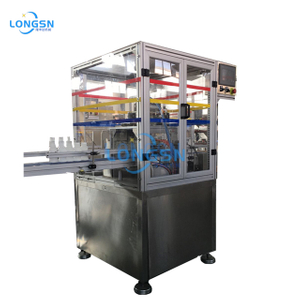In the fast-paced beverage industry, efficiency, precision, and quality are critical to maintaining competitive production lines. From bottled water to carbonated soft drinks, juices, and alcoholic beverages, the production process involves multiple stages, including filling, capping, labeling, and packaging. Among these steps, the proper preparation of bottles—especially the trimming or finishing of bottle necks—is a crucial factor that ensures smooth operation and high-quality output.
A bottle neck cutting machine plays an essential role in this process by precisely trimming bottle necks to meet standardized specifications. This not only guarantees uniformity for downstream operations such as capping and sealing but also improves production efficiency, reduces waste, and minimizes human error. Understanding the common applications of bottle neck cutting machines in the beverage industry highlights their importance and helps manufacturers optimize their production processes.
Ensuring Proper Fit for Caps and Closures
One of the primary applications of bottle neck cutting machines is to prepare bottles for capping and closures. In the beverage industry, bottle necks must meet precise dimensions to accommodate caps, lids, or dispensing mechanisms.
Improperly cut necks can lead to misaligned caps, leaks, or compromised product safety. Automated neck cutting machines ensure uniform neck diameters, smooth surfaces, and consistent angles, allowing caps to fit perfectly every time. This precision is particularly important for high-speed bottling lines, where misalignment can cause jams, slow production, or result in defective products.
By ensuring that each bottle neck is cut to exact specifications, manufacturers reduce the likelihood of capping errors and maintain product integrity, which is critical for consumer satisfaction and regulatory compliance.
Preparing Bottles for Carbonated Beverages
Carbonated drinks, such as soft drinks and sparkling water, require airtight sealing to maintain carbonation and freshness. Any irregularity in the bottle neck can compromise the seal, leading to gas leakage and reduced shelf life.
Bottle neck cutting machines play a crucial role in creating smooth, uniform neck surfaces that allow sealing machines to operate effectively. By producing consistently trimmed necks, these machines ensure that carbonated beverages retain their effervescence and quality from production to consumption.
In addition, precise neck cutting helps prevent excessive pressure buildup or deformation during carbonation, reducing the risk of bottle breakage or leaks. This application is vital for beverage producers aiming to deliver safe, high-quality products that meet consumer expectations.
Supporting Glass and Plastic Bottle Production
Beverage manufacturers use both glass and plastic bottles, each of which requires specialized handling during neck preparation. Bottle neck cutting machines are designed to accommodate different materials, including PET, HDPE, and glass, ensuring that the cutting process does not damage the bottles.
For glass bottles, the machine must trim the neck without causing cracks, chips, or stress points that could lead to breakage during filling or transport. For plastic bottles, the machine ensures smooth edges and proper dimensions without deforming the material.
This versatility allows manufacturers to use a single machine for multiple bottle types, reducing the need for separate equipment and optimizing production efficiency across different product lines.
Facilitating Multi-Batch Production
In the beverage industry, production lines often switch between multiple product types, sizes, and flavors. Bottle neck cutting machines support multi-batch production by allowing quick adjustments to cutting settings, blade angles, and feeding mechanisms.
This flexibility enables manufacturers to handle bottles of varying heights, diameters, and materials without significant downtime. Efficient multi-batch production ensures that beverage companies can respond to seasonal demand, promotions, or market trends without compromising speed or quality.
By reducing the time required to reconfigure machinery, neck cutting machines enhance overall production agility and enable higher throughput.
Improving Packaging Efficiency
Properly trimmed bottle necks contribute to smoother packaging operations. Bottles with uneven or improperly cut necks can cause problems in automated filling, capping, and labeling lines, resulting in jams, spills, or inconsistent labeling.
Bottle neck cutting machines ensure that every bottle is uniform, facilitating faster and more reliable packaging. This consistency reduces downtime, minimizes product loss, and allows packaging equipment to operate at optimal speed.
For manufacturers, this translates into lower operational costs, higher productivity, and reduced risk of defective or returned products. Efficient packaging is particularly important for high-volume beverage producers, where even small delays can impact overall output.
Supporting Quality Control and Compliance
Quality control is a top priority in the beverage industry. Regulatory agencies and consumers expect products to meet safety and quality standards. Bottle neck cutting machines contribute to quality assurance by producing consistent, defect-free bottle necks.
Uniform necks reduce the risk of leaks, contamination, or improper sealing, which are common concerns in beverage production. By maintaining strict tolerances, manufacturers can demonstrate compliance with industry standards and regulatory requirements.
In addition, precise neck cutting supports traceability and record-keeping for production lines, as each batch of bottles can be processed under standardized conditions. This level of control enhances overall product reliability and consumer confidence.
Enhancing Aesthetic Appeal and Branding
In addition to functional benefits, bottle neck cutting machines help maintain the visual appeal of bottled beverages. Smooth, evenly trimmed necks contribute to a polished, professional appearance, which is important for branding and market positioning.
Beverages compete not only on taste but also on presentation. Bottles that look uniform and high-quality convey a sense of reliability and premium value to consumers. This application is particularly important for products positioned in competitive retail environments or for premium brands that emphasize packaging aesthetics as part of their marketing strategy.
Reducing Material Waste
Material efficiency is another key application of bottle neck cutting machines. Precise cutting minimizes excess material removal and reduces the number of defective bottles caused by improper trimming.
By controlling waste, manufacturers can lower production costs and reduce environmental impact. Efficient material use is especially important in large-scale beverage production, where even small amounts of waste can translate into significant financial and resource losses over time.
This application aligns with sustainability initiatives in the beverage industry, helping companies reduce their carbon footprint while maintaining operational efficiency.
Integration with Automated Bottling Lines
Modern beverage facilities rely heavily on automation to maximize throughput and reduce labor costs. Bottle neck cutting machines are designed to integrate seamlessly into automated bottling lines, allowing for synchronized operations with filling, capping, and labeling machines.
Integration ensures that bottles flow smoothly through each stage of production without manual intervention. Advanced machines can detect misaligned bottles, automatically adjust cutting parameters, and communicate with upstream and downstream equipment for coordinated operation.
This integration enhances overall line efficiency, reduces downtime, and allows beverage manufacturers to operate at higher speeds without compromising quality.
Applications Across Beverage Types
Bottle neck cutting machines are versatile and find applications across a wide range of beverages, including:
Carbonated drinks: Ensuring airtight seals to preserve carbonation.
Bottled water: Maintaining consistent neck dimensions for universal cap compatibility.
Juices and smoothies: Supporting multi-batch production with different bottle sizes.
Alcoholic beverages: Providing smooth necks for corks, screw caps, or pour spouts.
Dairy products: Ensuring proper sealing to prevent spoilage and contamination.
By catering to diverse beverage types, these machines support operational flexibility and help manufacturers meet market demands efficiently.
Conclusion
Bottle neck cutting machines are essential in modern beverage production, ensuring proper cap fit, maintaining carbonation, supporting multi-batch production, improving packaging efficiency, and reducing material waste. By providing precision, consistency, and reliability, these machines enhance overall bottling efficiency, support quality control, and strengthen brand image. Integration with automated production lines further increases throughput, reduces labor costs, and minimizes downtime.
For beverage manufacturers aiming to optimize production and maintain high standards, investing in a bottle neck cutting machine is a strategic decision. These machines streamline the bottling process, guaranteeing that every product meets functional, aesthetic, and regulatory requirements. In an industry where speed, accuracy, and quality are paramount, bottle neck cutting machines play a crucial role in enabling efficient, safe, and sustainable beverage production.

 English
English









